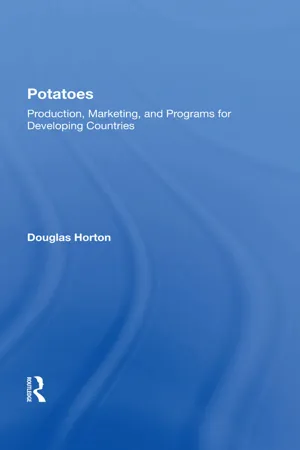
- 244 pages
- English
- ePUB (mobile friendly)
- Available on iOS & Android
About This Book
Although the potato is usually thought of as a temperate-zone crop, potato growing in the tropics and subtropics is spreading rapidly. In terms of the dollar value of the crop, this edible root now ranks fourth in the developing world after rice, wheat, and maize. Nevertheless, policymakers often underrate the importance of the potato as a source of employment, income, and food or they underestimate the potential benefits from expanding potato production and use. The payoff from applied research on potato cultivation in the tropics and subtropics is high due to the large body of scientific information from developed countries. This book summarizes the principles of potato production, distribution, and use. The essential facts about the potato as a crop, a commodity, and a food are discussed as well as the issues that scientists and policymakers should consider in setting priorities for implementing and assessing the impact of potato research and extension programs. A major premise of the book is that programs aiming to increase food supplies and reduce poverty through crop improvement need to consider not only production technology but also marketing strategies and consumption patterns. Adequate planning for agricultural research and development requires an understanding of how crops are grown, marketed, and used and of what potential benefits the new technologies can yield. Hence, effective crop improvement programs need both technical and socioeconomic expertise. The administrators and others responsible for implementing these programs must concern themselves with the policies that impinge on the adoption and consequences of new production methods so that their countries may reap the full benefits of an increased and stable food supply.
Frequently asked questions
Information
1
World patterns and trends in potato production and use
Origin and spread of the potato crop
South American origin
| Edible portion | ||||
| Crops | Production (million tons) | Dry matter (million tons) | Energy (trillion kcal) | Protein (million tons) |
| | ||||
| Cereals | ||||
| Wheat | 522 | 456 | 1,320 | 52.7 |
| Rice, paddy | 470 | 414 | 1,143 | 21.1 |
| Barley | 172 | 153 | 419 | 9.9 |
| Maize | 449 | 387 | 1,376 | 35.2 |
| Rye | 31 | 28 | 89 | 3.2 |
| Oats | 43 | 40 | 76 | 2.8 |
| Millet | 31 | 27 | 95 | 2.9 |
| Sorghum | 72 | 64 | 226 | 7.5 |
| Roots and Tubers | ||||
| Potatoes | 312 | 63 | 192 | 5.3 |
| Sweet potatoes | 117 | 34 | 108 | 1.6 |
| Cassava | 129 | 52 | 110 | 0.5 |
| Yams | 25 | 7 | 22 | 0.5 |
| Cocoyams | 6 | 2 | 5 | 0.1 |
| Pulses | ||||
| Beans, dry | 15 | 14 | 53 | 3.4 |
| Broad-beans, dry | 4 | 4 | 14 | 1.0 |
| Peas, dry | 11 | 9 | 36 | 2.6 |
| Chickpeas | 7 | 6 | 23 | 1.3 |
| Lentils | 2 | 1 | 5 | 0.4 |
| Oilseeds | ||||
| Soybeans | 90 | 81 | 362 | 30.7 |
| Groundnuts in shell | 21 | 19 | 85 | 3.9 |
| Vegetables | ||||
| Cabbages | 38 | 3 | 7 | 0.4 |
| Tomatoes | 59 | 4 | 11 | 0.6 |
| Onions, dry | 23 | 3 | 8 | 0.3 |
| Carrots | 12 | 1 | 4 | 0.1 |
| Bananas & plantains | 61 | 21 | 53 | 0.5 |

Table of contents
- Cover
- Half Title
- Series Page
- Title
- Copyright
- Contents
- List of Tables and Figures
- Foreword
- Acknowledgments
- Introduction
- 1 World patterns and trends in potato production and use
- 2 The potato crop and its physical environment
- 3 The socioeconomic environment: Levels of development and public policies
- 4 Supply, demand, and marketing
- 5 Potato nutrition and consumption
- 6 Potato production systems
- 7 Research priorities and potato programs
- 8 Impact of potato programs
- 9 Summing up
- References
- Index
- About the Book and Author